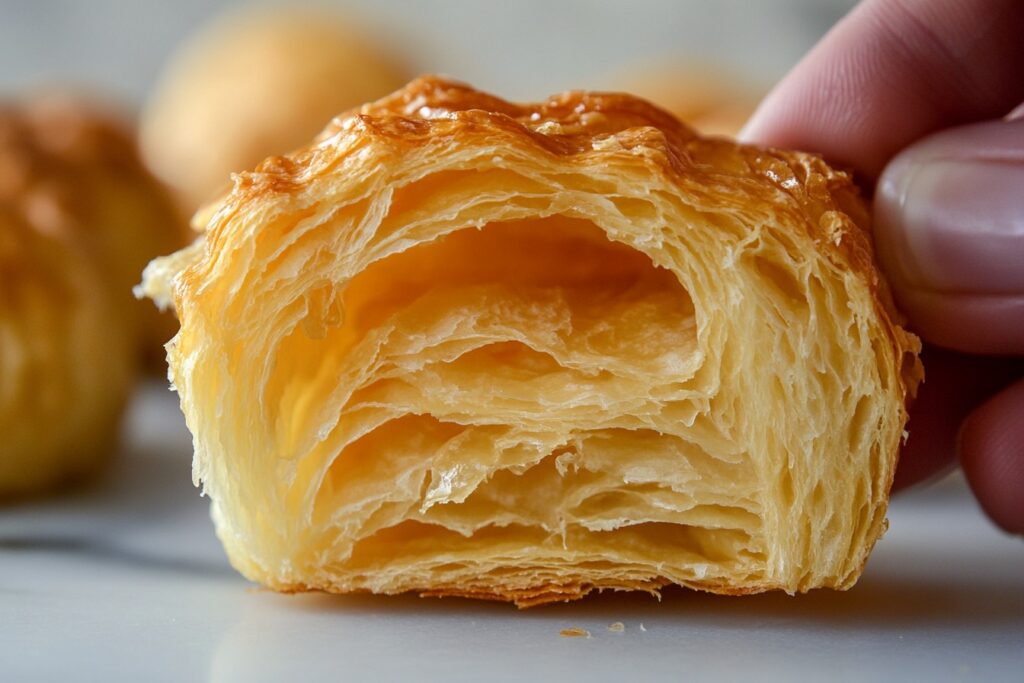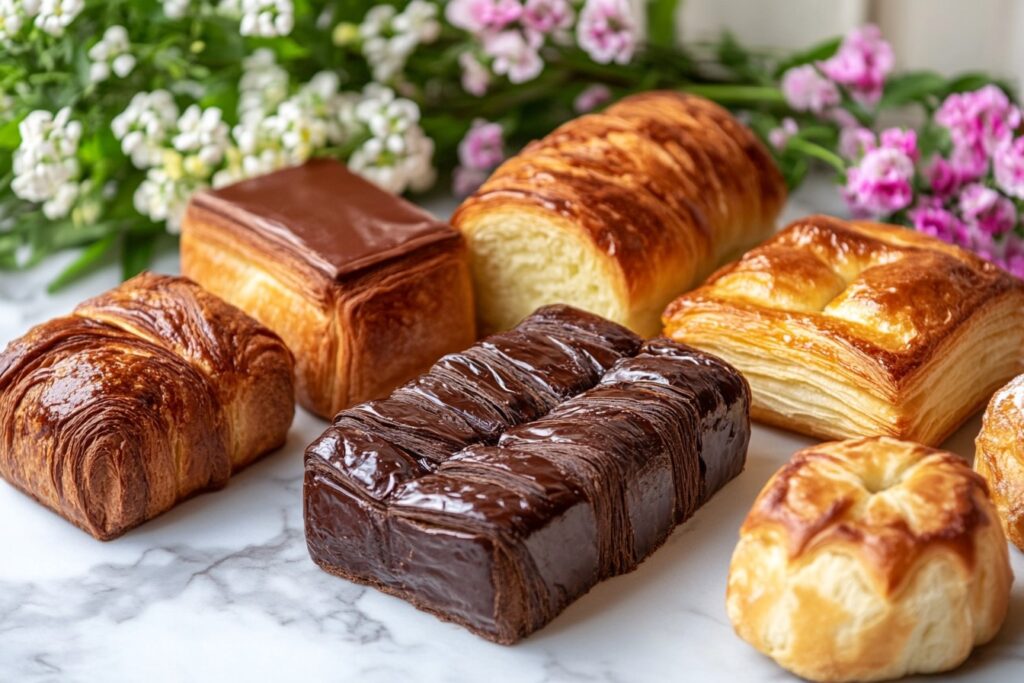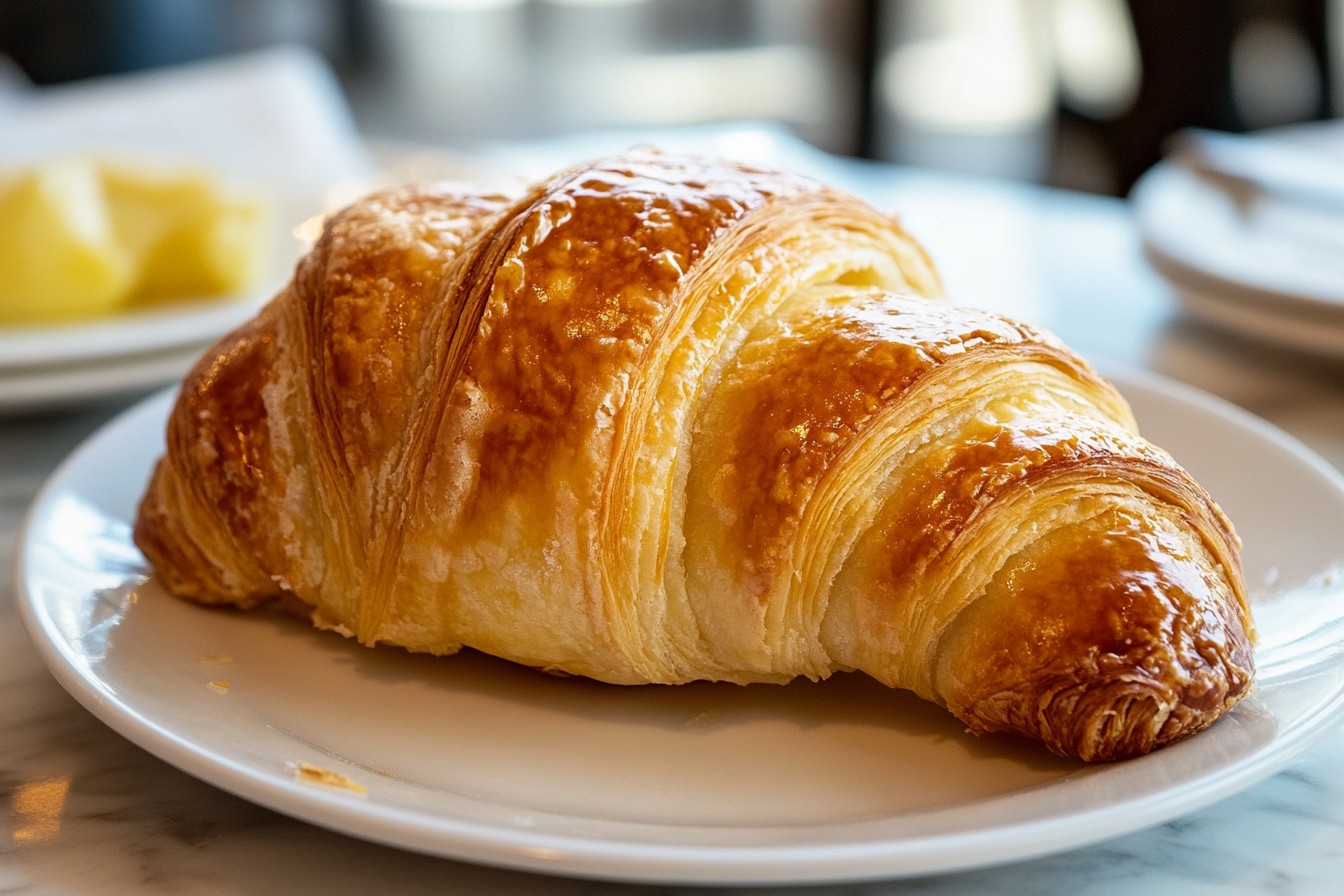Breakfast in France is more than just a meal—it’s an experience that blends simplicity and sophistication. French breakfast pastries have earned worldwide fame for their flaky textures, buttery flavors, and irresistible aromas. In this article, we’ll explore some of the most iconic French pastries, their origins, cultural significance, and why they’ve become breakfast staples around the world. From the universally loved croissant to the decadent pain au chocolat, we’ll uncover the secrets of these culinary masterpieces and provide insights into their global appeal.
Introduction to French Breakfast Pastries
The Role of Pastries in French Breakfast Culture
In France, breakfast is typically a light affair, often centered around simple yet elegant pastries. While a hearty meal may be reserved for later in the day, breakfast is about savoring the moment—perhaps accompanied by a café au lait. Pastries like croissants and pain au chocolat are not just food but a cultural ritual. They embody the French philosophy of living well and taking pleasure in life’s little joys.
For the French, breakfast pastries are an expression of craftsmanship. Every bite speaks of dedication to tradition and the art of pastry-making. Whether enjoyed at home, at a cozy boulangerie, or at a bustling café, these treats set the tone for the day ahead.
Historical Background of French Breakfast Pastries
The history of French pastries is as rich and layered as the pastries themselves. Many breakfast staples, like the croissant, actually trace their origins back to Austria, where a similar pastry called the “kipferl” was first created. However, it was French bakers who perfected the art of laminating dough, transforming it into the flaky, buttery masterpiece we know today.
Other iconic pastries, like brioche and kouign-amann, have deep regional roots. These creations highlight the diversity of French culinary traditions, showcasing how different regions contribute their unique flair to the breakfast table.
Why French Breakfast Pastries Are Renowned Worldwide
It’s no secret that French pastries have conquered the world. Their reputation stems from the impeccable techniques used to create them, the quality of ingredients like creamy butter and fine flour, and the passion that goes into every recipe. The croissant alone has inspired countless variations, from chocolate-filled delights to almond-crusted renditions.
This global fascination isn’t just about taste—French pastries symbolize luxury, artistry, and indulgence. They’ve become synonymous with sophistication, making them a must-try for travelers and a beloved treat for locals and expatriates alike.
Exploring the Most Famous French Breakfast Pastries
Croissant – The Iconic French Breakfast Pastry

The buttery, flaky layers of a classic croissant.
When someone asks, ‘What is a famous French breakfast pastry?’ most people immediately think of the croissant. This crescent-shaped, buttery delight symbolizes French culinary excellence. French bakers transformed Austria’s kipferl into the airy, flaky treat that people adore today.
Making a croissant is an art. It involves laminating dough with layers of high-quality butter, creating the characteristic golden, crisp crust that flakes apart with every bite. A croissant pairs perfectly with a café au lait or a hot chocolate, making it a quintessential part of French mornings.
You can learn more about the art of pastry-making at this guide on breakfast pastries.
Pain au Chocolat – A Close Rival to the Croissant
Known as the croissant’s chocolatey cousin, pain au chocolat equally delights pastry lovers. Bakers create this rectangular pastry from the same laminated dough as croissants but fill it with rich, melted chocolate. The crisp, buttery exterior contrasts beautifully with the gooey chocolate center, making it irresistible.
Pain au chocolat is often enjoyed as a quick breakfast or an indulgent snack. In France, children often grab one on their way to school, making it a nostalgic favorite for many.
Brioche – A Versatile and Sweet Morning Treat
Soft, pillowy, and slightly sweet, brioche is another iconic French breakfast option. This bread-like pastry has a rich flavor due to its high butter and egg content. Unlike croissants, brioche is less flaky but just as satisfying.
Brioche is versatile—it can be toasted and topped with jam or Nutella or enjoyed plain with a cup of coffee. Its adaptability has made it a staple in French households and bakeries alike.
Kouign-Amann – The Buttery Pastry with a Twist
Hailing from Brittany, kouign-amann (pronounced kween-ah-mahn) is a lesser-known gem among French breakfast pastries. Its name translates to “butter cake,” and it’s exactly as indulgent as it sounds. This pastry combines laminated dough with caramelized sugar, creating a crispy, sweet crust with a moist, buttery interior.
The complex textures and flavors of kouign-amann make it a standout, even in the competitive world of French pastries.
Madeleines – A Unique Breakfast Delight
Madeleines are small, shell-shaped cakes that often accompany French breakfasts. These sponge-like pastries have a subtle lemon or vanilla flavor, making them perfect for dipping in tea or coffee. Though less flaky than other pastries, madeleines are loved for their light texture and delicate taste.
How French Breakfast Pastries Are Made
Traditional Ingredients Used in French Pastries
The foundation of any great French pastry lies in its ingredients. In fact, authentic recipes often call for simple yet high-quality components: flour, butter, sugar, eggs, and sometimes milk. Moreover, French butter, renowned for its high-fat content, plays a key role in creating the signature flaky texture and rich flavor of pastries like croissants and brioche. As a result, these pastries achieve their iconic taste and texture that delights pastry lovers worldwide.
Techniques Behind Making Flaky and Light Pastries
Creating pastries like croissants and pain au chocolat requires patience and precision. The hallmark of these pastries is the lamination process, where butter is layered between sheets of dough. This technique, combined with folding and rolling, creates thin layers that puff up beautifully in the oven.
The dough is then proofed to allow yeast fermentation, which adds flavor and ensures a light, airy texture.
The Importance of Lamination in Pastry Dough
Lamination isn’t just a technique; it’s an art. The process involves folding and chilling the dough repeatedly to achieve perfect layers. This technique not only creates the iconic texture of French pastries but also traps steam during baking, leading to the characteristic flaky exterior.
If you’re intrigued by this process, explore more on pastry techniques in this guide.
French Breakfast Pastries and Their Global Appeal

An assortment of French pastries like brioche and pain au chocolat.
Why These Pastries Are Popular Beyond France
French breakfast pastries captivate a global fanbase, and it’s no surprise why. Their buttery, flaky textures and rich flavors draw in pastry lovers everywhere. What is a famous French breakfast pastry? The answer often includes croissants and pain au chocolat, which symbolize indulgence and luxury. Bakers and chefs serve these treats in bustling bakeries or elegant hotels to evoke the charm and sophistication of French culture.
Pastry enthusiasts worldwide admire techniques like lamination and proofing behind these delicacies. Countries such as the United States, Japan, and Australia embrace French pastries, adapting them to local tastes while preserving their essence. For example, bakers in Asia create popular fusions like matcha croissants, merging French craftsmanship with unique flavors.
To explore more about how pastries are made with creative twists, visit this article on pastry recipes.
How Croissants Became a Worldwide Breakfast Staple
The croissant didn’t remain a French secret for long. By the 20th century, these pastries were found in cafés and bakeries across Europe and the Americas. In recent years, the croissant has evolved, with gourmet versions featuring almond paste, chocolate drizzles, or even savory fillings like ham and cheese.
Global food trends, such as the “cronut” (a hybrid of a croissant and donut), showcase the croissant’s versatility. This innovation highlights how French breakfast pastries continue to inspire culinary creativity around the world.
FAQs About French Breakfast Pastries
What is the Name for French Breakfast Pastries?
French breakfast pastries are often referred to as viennoiseries. This category includes favorites like croissants, pain au chocolat, and brioche. The term reflects their Austrian roots, as well as the French artistry that elevated them into culinary icons.
What is the Most Popular Pastry in France?
The croissant holds the crown as the most beloved pastry in France. Its buttery layers and crisp texture make it a go-to breakfast option. Other contenders, such as pain au chocolat and brioche, also enjoy widespread popularity, especially among those who prefer a sweeter start to the day.
Do the French Eat Pastries for Breakfast?
Absolutely! In France, breakfast is often a light, relaxed meal, featuring a pastry, coffee, and sometimes fresh fruit. While not every day includes a croissant, enjoying a viennoiserie is a common treat, particularly on weekends or special occasions.
What is the Famous Breakfast in France?
A typical French breakfast consists of a pastry, such as a croissant or pain au chocolat, paired with a steaming cup of coffee or hot chocolate. This simple yet satisfying combination captures the essence of French cuisine: quality over quantity.
If you’re curious about other delicious breakfast options or recipes, check out our article on breakfast pastry recipes.
Where to Find Authentic French Breakfast Pastries
Best Bakeries in France for Traditional Pastries
France boasts some of the world’s best bakeries, where skilled artisans craft authentic viennoiseries. In Paris, bakeries like Du Pain et des Idées and Boulangerie Poilâne earn acclaim for their exquisite croissants and pain au chocolat. Outside the capital, regional gems such as Maison Georges Larnicol in Brittany and Pâtisserie Intuitions in Cannes highlight local specialties like kouign-amann and fine brioches.
When you visit a French bakery, look for signs of quality: a rich golden color, crisp outer layers, and the unmistakable aroma of fresh butter. For those asking, “What is a famous French breakfast pastry?” the answer often begins in these charming boulangeries.
How to Identify High-Quality French Pastries
Authentic French pastries are crafted with care. A perfect croissant, for example, should have a crescent shape, even lamination, and a satisfying crackle when bitten into. Similarly, a well-made pain au chocolat will boast a flaky exterior and generous layers of smooth chocolate.
Avoid pastries that seem overly greasy or flat—bakers might have used lower-quality butter or taken shortcuts in the lamination process.A genuine French pastry is as much about the craftsmanship as the taste.
Tips for Enjoying French Breakfast Pastries at Home
Pairing Pastries with Coffee or Tea
One of the joys of French breakfast pastries is how beautifully they pair with beverages. A croissant or pain au chocolat is best enjoyed with a steaming cup of coffee or espresso. For those who prefer tea, a delicate black or green tea complements the buttery layers without overpowering the flavors. Hot chocolate is another classic option, especially for children or those seeking a sweeter indulgence.
Storage Tips to Keep Pastries Fresh
If you’re lucky enough to bring home some French pastries, proper storage is key. Keep them in a paper bag at room temperature for up to a day to preserve their crispness. Avoid plastic bags, as they can trap moisture and ruin the flaky texture. For longer storage, freeze pastries in an airtight container and reheat them in the oven to bring back their fresh-from-the-bakery appeal.
Reheating and Serving Suggestions
To enjoy your pastries at their best, reheat them in a preheated oven at 180°C (350°F) for 5-10 minutes. This method revives the crisp, golden exterior and warms the interior to perfection. Serve them fresh with a dollop of jam or a dusting of powdered sugar for a touch of elegance.
Conclusion: Why French Breakfast Pastries Are Timeless Classics
The Enduring Charm of French Pastries
French breakfast pastries have stood the test of time, capturing hearts and taste buds around the globe. From the flaky layers of a croissant to the buttery richness of a pain au chocolat, these treats embody simplicity and sophistication. They are not just food but a celebration of craftsmanship, tradition, and quality.
When someone asks, “What is a famous French breakfast pastry?” the answer inevitably evokes images of Parisian cafés, golden pastries glistening in display cases, and the comforting aroma of freshly baked dough. Their enduring charm lies in their ability to turn an ordinary morning into something extraordinary.
Inspiring Your Own French Breakfast Ritual
Whether you’re enjoying authentic pastries from a bakery or recreating them at home, French breakfast pastries inspire moments of indulgence. Pairing them with a hot drink and savoring every bite is a ritual that brings a touch of French elegance to any day. They remind us to slow down, enjoy life’s simple pleasures, and appreciate the artistry of food.
Frequently Asked Questions About French Breakfast Pastries
What is a Famous French Breakfast Pastry?
When it comes to answering “What is a famous French breakfast pastry?”, the croissant takes center stage. Its buttery layers and delicate texture have made it a universal symbol of French cuisine. Other well-loved options include pain au chocolat, brioche, and kouign-amann.
What Sets French Pastries Apart from Others?
French pastries are distinguished by their exceptional quality and techniques. The use of fine ingredients, like high-fat butter and refined flour, combined with methods like lamination, create pastries with unmatched texture and flavor.
Are French Breakfast Pastries Hard to Make?
While French breakfast pastries require precision and patience, they’re not impossible to make at home. With practice and high-quality ingredients, you can replicate the magic of a bakery-fresh croissant or brioche.
Where Can I Learn More About French Breakfast Pastries?
For more insights into crafting or enjoying these treats, explore this guide to breakfast pastries. It’s a great resource for understanding the variety and artistry behind French pastries.
